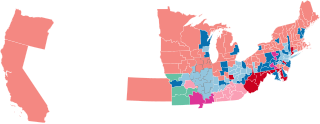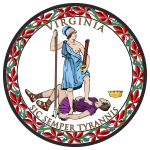
The 2000 United States House of Representatives elections were held on November 7, 2000, to elect U.S. Representatives to serve in the 107th United States Congress. They coincided with the election of George W. Bush as President of the United States. The Republican Party won 221 seats, while the Democratic Party won 212 and independents won two.

The 1974 United States House of Representatives elections were elections for the United States House of Representatives on November 5, 1974, to elect members to serve in the 94th United States Congress. They occurred in the wake of the Watergate scandal, which had forced President Richard Nixon to resign in favor of Gerald Ford. This scandal, along with high inflation, allowed the Democrats to make large gains in the midterm elections, taking 48 seats from the Republicans, and increasing their majority above the two-thirds mark. Altogether, there were 93 freshmen representatives in the 94th Congress when it convened on January 3, 1975. Those elected to office that year later came to be known collectively as "Watergate Babies." The gain of 49 Democratic seats was the largest pickup by the party since 1958. Only four Democratic incumbents lost their seats.

The 1862–63 United States House of Representatives elections were held on various dates in various states between June 2, 1862, and November 3, 1863, during the American Civil War and President Abraham Lincoln's first term. Each state set its own date for its elections to the House of Representatives before the first session of the 38th United States Congress convened on December 7, 1863. The congressional reapportionment based on the 1860 United States Census was performed assuming the seceded states were still in the union, increasing the number of congressional districts to 241. West Virginia was given three seats from Virginia after the former broke away from the latter to rejoin the union as a separate state. The seceded states remained unrepresented and left 58 vacancies. Republicans lost 22 seats and the majority, while Democrats gained 28.

The 2006 United States House of Representatives elections in Virginia were held on November 7, 2006 to determine who will represent the Commonwealth of Virginia in the United States House of Representatives. Virginia has eleven seats in the House, apportioned according to the 2000 United States Census. Representatives are elected for two-year terms.

Virginia's 10th congressional district is a U.S. congressional district in the Commonwealth of Virginia. It is currently represented by Democrat Jennifer Wexton, who was first elected in 2018.

The United States House of Representatives elections in California, 1974 was an election for California's delegation to the United States House of Representatives, which occurred as part of the general election of the House of Representatives on November 4, 1974. Democrats picked up five Republican-held districts.

The 1980 United States House of Representatives elections in Virginia were held on November 4, 1980 to determine who will represent the Commonwealth of Virginia in the United States House of Representatives. Virginia had ten seats in the House, apportioned according to the 1970 United States Census. Representatives are elected for two-year terms.

The 2000 United States House of Representatives elections in Virginia were held on November 7, 2000 to determine who will represent the Commonwealth of Virginia in the United States House of Representatives. Virginia has eleven seats in the House, apportioned according to the 1990 United States Census. Representatives are elected for two-year terms.

The 1930 United States House of Representatives elections in Virginia were held on November 4, 1930 to determine who will represent the Commonwealth of Virginia in the United States House of Representatives. Virginia had ten seats in the House, apportioned according to the 1920 United States Census. Representatives are elected for two-year terms.

The 1938 United States House of Representatives elections in Virginia were held on November 8, 1938 to determine who would represent the Commonwealth of Virginia in the United States House of Representatives. Virginia had nine seats in the House, apportioned according to the 1930 United States Census.

The 1952 United States House of Representatives elections in Virginia were held on November 4, 1952 to determine who will represent the Commonwealth of Virginia in the United States House of Representatives. Virginia gained an additional seat, having ten seats in the House apportioned according to the 1950 United States Census. Representatives are elected for two-year terms. Until this election, the Democratic Party had won every seat since 1932.

The 1958 United States House of Representatives elections in Virginia were held on November 4, 1958 to determine who will represent the Commonwealth of Virginia in the United States House of Representatives. Virginia had ten seats in the House, apportioned according to the 1950 United States Census. Representatives are elected for two-year terms.

The 1978 United States Senate election in Virginia was held on November 7, 1978. Incumbent Republican Senator William L. Scott did not run for re-election to a second term. Republican former Secretary of the Navy John Warner narrowly defeated Democratic Attorney General of Virginia Andrew P. Miller to succeed him. Originally, this election was a match between Republican Richard Obenshain and Miller, then Obenshain died in a plane crash, leaving the party in disarray. Warner was then nominated to run in Obenshain's place, and his victorious election thrust him into a thirty-year career in the United States Senate, which started with this election.

The 1998 United States House of Representatives elections in Virginia were held on November 3, 1998, to determine who will represent the Commonwealth of Virginia in the United States House of Representatives. Virginia has eleven seats in the House, apportioned according to the 1990 United States Census. Representatives are elected for two-year terms.

The 1986 United States House of Representatives elections in Virginia were held on November 4, 1986 to determine who will represent the Commonwealth of Virginia in the United States House of Representatives. Virginia had ten seats in the House, apportioned according to the 1980 United States Census. Representatives are elected for two-year terms.

The 1984 United States House of Representatives elections in Virginia were held on November 6, 1984 to determine who will represent the Commonwealth of Virginia in the United States House of Representatives. Virginia had ten seats in the House, apportioned according to the 1980 United States Census. Representatives are elected for two-year terms.

The 1968 United States House of Representatives elections in Virginia were held on November 5, 1968, to determine who will represent the Commonwealth of Virginia in the United States House of Representatives. Virginia had ten seats in the House, apportioned according to the 1960 United States Census. Representatives are elected for two-year terms.

The 1940 United States House of Representatives elections in Virginia were held on November 5, 1940 to determine who will represent the Commonwealth of Virginia in the United States House of Representatives. Virginia had nine seats in the House, apportioned according to the 1930 United States Census. Representatives are elected for two-year terms.

The 1934 United States House of Representatives elections in Virginia were held on November 6, 1934 to determine who will represent the Commonwealth of Virginia in the United States House of Representatives. Virginia had nine seats in the House, apportioned according to the 1930 United States Census. Representatives are elected for two-year terms. This election was notable for the state's return to electoral district voting after briefly experimenting with electing all Representatives at-large in the previous election.

The 1924 United States House of Representatives elections in Virginia were held on November 4, 1924, to determine who will represent the Commonwealth of Virginia in the United States House of Representatives. Virginia had ten seats in the House, apportioned according to the 1920 United States Census. Representatives are elected for two-year terms.







